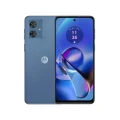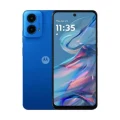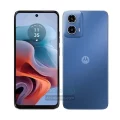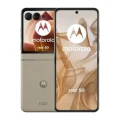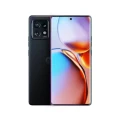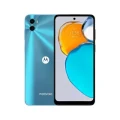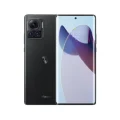Motorola Moto G24
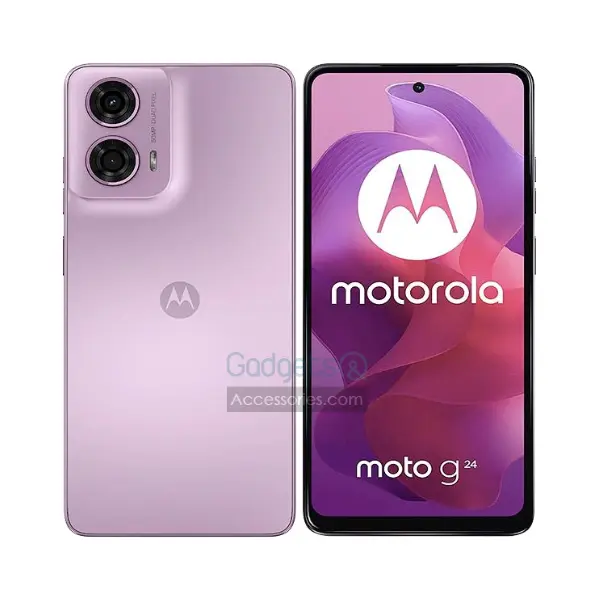
Motorola Moto G24 - Specifications
General
| Device Type | Smart Phone |
| Model | N/A |
| Announced | 23 January, 2024 |
| Release Date | 31 January, 2024 |
| Estimated Price | $150 to $250 |
Network
| 2G Network | GSM 850 / 900 / 1800 / 1900 - SIM 1 & SIM 2 |
| 3G Network | HSDPA 850 / 900 / 1900 / 2100 |
| 4G Network | LTE |
| 5G Network | N/A |
| SIM SIM (Subscriber Identity Module) is a small card that contains mobile network subscriber's account information. This allows the phone using the card to attach to a mobile network. The SIM card is most commonly associated with GSM and UMTS mobile networks. Moving a SIM card from one phone to another allows a subscriber to switch mobile phones without having to contact their mobile network carrier. SIM cards can also be used by a phone to store limited amounts of data, such as phone numbers and text messages. | Nano-SIM or Dual SIM (Nano-SIM, dual stand-by) Water-repellent design |
| Dual SIM | Yes |
| eSIM | No |
Camera
| Primary Camera is able to capture photographs and usually videos, The most important characteristics of a camera are the resolution (measured in megapixels), lens focus type (fixed or automatic), higher megapixel cameras are known to capture higher quality photos, but not always a good measurement of the photos quality. | 50 MP, f/1.8 (wide), 0.64µm, PDAF 2 MP, f/2.4, (macro) |
| Video | 1080p@30fps |
| Camera Features | LED flash, HDR, panorama |
| Built-In Flash Flash Light => There is commonly two types of flash lights are used in camera mobile phones, LED Flash (LED flash offers lower power consumption with drive circuitry that takes up very little room, LEDs can be strobed faster than any other light source), Xenon Flash (xenon flash produces an extremely intense full-spectrum white light for a very short duration) | Yes |
| Secondary | 8 MP, f/2.0, (wide), 1.12µm |
Display
| Display Type Display Technology => A number of display technologies and types used in mobile phones => TFT (Thin Film Transistor), IPS (In-Place Switching), OLED (Organic Light Emitting Diode), AMOLED (Active-Matrix Organic Light-Emitting Diode), Super AMOLED (an even advanced version of AMOLED), Resistive Touchscreen (Resistive touchscreens contain two layer of conductive material with a very small gap between them which acts as a resistance), Capacitive Touchsceen (Capacitive touchscreen technology consists of a layer of glass coated with a transparent conductor) | IPS LCD, 90Hz, 570 nits |
| Size | 6.56 inches, 103.4 cm2 (~84.6% screen-to-body ratio) |
| Touch Screen | Multi-touch |
| Resolution | 720 x 1612 pixels, 20:9 ratio (~269 ppi density) |
| Display Colors Display Colors is refers to the number of different shades of colors that the screen is capable of displaying => 64K colors, 256K colors and 16 million colors, Obviously 16M is highest available range of colors and better than others. | 16M Colors |
| Pixel Density Pixel Density (PPI) is refers to the concentration of pixels on a particular display, measured in pixels per inch (ppi). Pixel density is calculated by dividing the diagonal pixel resolution of a display by its diagonal size, higher pixel density better display quality. | (~269 ppi density) |
Design
| Dimensions | 163 x 75 x 8 mm (6.42 x 2.95 x 0.31 in) |
| Weight | 180 g (6.35 oz) |
| Protection | Glass front, plastic back, plastic frame |
| Colors | Matte Charcoal, Ice Green, Blueberry, Pink Lavender |
Media
| Radio | Unspecified |
| Loudspeaker | Yes, with stereo speakers |
Software
| Operating System OS => Every computer system run on a base software called Operating System (OS). Operating System controls all basic operations of the computer (such as smartphone, PDAs, tablet computers and other handheld devices). The Operating System allows the user to install and run third party applications (apps), apps are used to add new functionality to the device. | Android 14 |
Hardware
| Chipset Chipset is a group of integrated circuits designed to perform one or a more dedicated functions, often with real time computing constraints, Popular smartphones are equipped with more advanced embedded chipsets that can do many different tasks depending on their programming. | Glass front, plastic back, plastic frame |
| CPU CPU (Central Processing Unit) mostly known as processors, CPU processes instructions in order to carry out certain functions that make your device operate properly. Processors are often described as the brain of computers, smartphones and tablets, Smartphones and tablets rely on processors to carry out their every task, Processors are an incredibly important factor in selecting any type of computing device, including your smartphone. | Octa-core (2x2.0 GHz Cortex-A75 & 6x1.8 GHz Cortex-A55) |
| GPU GPU (Graphics Processing Unit) is a single-chip processor designed to rapidly manipulate and alter memory to accelerate the creation of images in a frame buffer intended for output to a display, This includes things such as lighting effects, object transformations, and 3D motion. | Mali-G52 MC2 |
| RAM (Memory) RAM (Random Access Memory) is a type of computer memory that can be accessed randomly, any byte of memory can be accessed without touching the preceding bytes that allows information to be stored and accessed quickly from random locations. RAM is the most common type of memory found in computer systems, smartphones, tablets and other electronic devices. | 4GB |
| Internal Storage Internal Storage is a data storage space (flash memory) mostly used in smartphones, tablets and other electronic devices where operating system, apps, music, photos, videos, files and other user data Is stored. | 128GB |
| Card Slot Memory Card Slot is a special slot for inserting a memory card. Memory cards allow you to expand the phone's built-in memory, A memory card (sometimes called a flash memory card or a storage card) is a small storage medium used to store data such as text, pictures, audio, and video, for use on small, portable or remote computing devices such as mobile phones, mp3 players, digital cameras. | microSDXC (uses shared SIM slot) |
| Sensors Sensors are electronic components that detects and responds to some type of input from the physical environment. The specific input could be light, heat, motion, moisture, pressure and location, The output is generally a signal that is converted to use in computing systems, a location sensor, such as a GPS receiver is able to detect current location of your electronic device. | Fingerprint (side-mounted), accelerometer, gyro, proximity, compass |
Connectivity
| Bluetooth Bluetooth is a wireless communications technology for exchanging data between mobile phones, headsets, computers and other network devices over short distances without wires, Bluetooth technology was primarily designed to support simple wireless networking of personal consumer devices. | 5.0, A2DP, LE |
| Infrared Infrared connectivity is an old wireless technology used to connect two electronic devices. It uses a beam of infrared light to transmit information and so requires direct line of sight and operates only at close range. | |
| Wi-fi Wi-Fi is a popular wireless networking technology using radio waves to provide high-speed network connections that allows devices to communicate without cords or cables, Wi-Fi is increasingly becoming the preferred mode of internet connectivity all over the world. | Wi-Fi 802.11 a/b/g/n/ac, dual-band |
| Wi-fi Hotspot | |
| USB | USB Type-C 2.0 |
| GPS GPS The Global Positioning System is a satellite-based radio navigation system, GPS permits users to determine their position, velocity and the time 24 hours a day, in all weather, anywhere in the world, In order to locate your position, your device or GPS receiver must have a clear view of the sky. | GPS, GALILEO, GLONASS, BDS |
| NFC NFC (Near field communication) is a set of standards for smartphones and similar devices to establish peer-to-peer radio communications with each other by touching them together or bringing them into proximity, usually no more than a few inches. | |
| HDMI HDMI (High-Definition Multimedia Interface) is a compact audio/video interface for transferring uncompressed video data and compressed or uncompressed digital audio data from a HDMI-compliant source device to a compatible computer monitor, video projector, digital television, or digital audio device. | |
| Wireless Charging Wireless Charging (Inductive Charging) uses an electromagnetic field to transfer energy between two objects. This is usually done with a charging station. Energy is sent through an inductive coupling to an electrical device, which can then use that energy to charge batteries or run the device. | N/A |
Data
| GPRS GPRS (General Packet Radio Service) is a packet oriented mobile data service on the 2G and 3G cellular communication system's global system for mobile communications (GSM), Generally, GPRS is used for the purpose of wireless data transfer, such as sharing pictures and videos or browsing the Internet via a mobile phone connection. | |
| EDGE EDGE (Enhanced Data GSM Environment) is a wireless network technology generally considered the next step in the 2G network offers data transfer rates up to four times faster than ordinary GSM networks, Generally, EDGE is used for the purpose of wireless data transfer, such as sharing pictures and videos or browsing the Internet via a mobile phone connection. | |
| Speed | HSPA, LTE |
| Web Browser Web Browser => a web browser is a software application used to locate, retrieve and display content on the World Wide Web, including Web pages, images, video and other files, The primary function of a web browser is to render HTML, the code used to design or markup webpages. | HTML5 |
Messaging
| SMS SMS (Short Messaging Service) is a text messaging service component of phone, Web, or mobile communication systems. It uses standardized communications protocols to allow mobile phone devices to exchange short text messages over the networks. | Yes (threaded view) |
| MMS MMS (Multimedia Messaging Service) is a standard way to send messages that include multimedia content (audio clips, video clips and images) to and from mobile phones over wireless networks using the WAP protocol. | |
| Email Email (Electronic Mail) is a system for receiving, sending, and storing electronic messages, Similar to a letter, email is text messages that may contain files, images, or other attachments sent via the internet to a recipient by using applications and software prograps. An email address is required to receive email, and that address is unique to the user. | Yes |
| IM IM (Instant Messaging) is an exchange of text messages through a software application, it enable you to create a kind of private chat room with another individual in order to communicate in real time over the Internet. | Yes |
Battery
| Battery Type Battery Type => Cell phones run on various kinds of batteries depending on the manufacturer, phone size or shape and features. There are basically four types of cell phone batteries => Lithium Polymer, Lithium Ion, Nickel Metal Hydride and Nickel Cadmium. | Li-Po |
| Capacity Battery Capacity is a measure (typically in Amp-hr) of the charge stored by the battery, and is determined by the mass of active material contained in the battery. The battery capacity represents the maximum amount of energy that can be extracted from the battery under certain conditions. | 5000 mAh |
| Placement | Non-Removable |
| Charging | 15W wired |
The Motorola Moto G24 price in Pakistan starts from Rs. 37,999. The Motorola Moto G24 has 4GB RAM and 128GB Storage with Android 14 and comes in Matte Charcoal, Ice Green, Blueberry, Pink Lavender colors. Motorola has been a reliable contender in the mid-range smartphone market, and the Motorola Moto G24 follows suit. Offering a range of features at an affordable price, this device strives to provide an enjoyable user experience without being too expensive.
Display
The Moto G24 has a bright, colorful 6.56-inch screen with a 720 x 1612 pixels resolution. The display has good viewing angles and is great for watching videos and other media. The 90Hz refresh rate makes the user experience smoother with better animations and scrolling.
Camera
The device has two cameras, one with a 50MP resolution for the primary camera and an 8MP camera on the front. The Moto G24 has a great camera setup, considering its price. It has three cameras on the back, including a primary sensor, a wide-angle lens, and a depth sensor, allowing users to take clear and detailed photos of different scenes. The front camera is also suitable for taking high-quality selfies.
Design
The Moto G24 has a similar design to previous models, with a sleek and simple look. It has a 6.56-inch Full HD+ screen with a small hole for the front camera. The slim borders and fingerprint sensor built into the power button give it a modern and clean appearance. The plastic back has a textured finish that provides grip and prevents fingerprints, keeping the device looking good.
Performance
Thanks to its powerful octa-core processor and sufficient RAM, the Moto G24 can handle multitasking and demanding applications effortlessly. Whether playing games with high-quality graphics or using several apps simultaneously, this smartphone guarantees seamless performance.
Software
The Moto G24 uses a nearly stock version of Android with added features from Motorola. Its user interface is clean and easy to use, providing a seamless experience. Regular software updates keep the device current with the newest features and security patches.
Connectivity
The Moto G24 can connect to 5G networks for faster internet speeds. It also includes NFC technology for easy and secure contactless payments.
Storage
The Moto G24 has much storage space, offering 4GB and 128GB version options. This means users can store many photos, videos, apps, and documents without worrying about running out of space. Additionally, the phone has a microSD card slot for expandable storage, allowing users to increase their storage as needed.
Battery
The Moto G24 has a strong battery with a capacity of 5000mAh and is 15W wired, allowing for extended usage without worrying about battery life. Whether you use your phone heavily or casually, the Moto G24 guarantees enough power to last the entire day.
Motorola has enhanced the power management system on the Moto G24, making it more efficient while maintaining high performance. The device intelligently distributes power to apps based on their use, ensuring a smooth user experience. This allows users to enjoy gaming, streaming, and social media browsing without concerns about sudden battery drainage.
Conclusion
The Moto G24 is a budget-friendly smartphone that maintains the Moto G series’ reputation by providing an attractive package at an affordable price. It has a stylish design, impressive performance, a versatile camera, and a durable battery, making it a strong competitor in the midrange market. If you’re looking for a reasonably priced smartphone that doesn’t skimp on essential features, the Moto G24 is worth checking out.
Moreover, the phone will be available to buy online soon on websites like OLX, Daraz, and PriceOye. You can also find it in other popular online stores in Pakistan. For the latest phones, smartwatches, and tablets, check out the best deals, coupons, offers, comparisons, reviews, and more!!!



